Gardening in June is a favourite time for me with long light filled evenings leading up to the longest day of the year on the 21st and it seems a crime to be indoors before 9 pm !
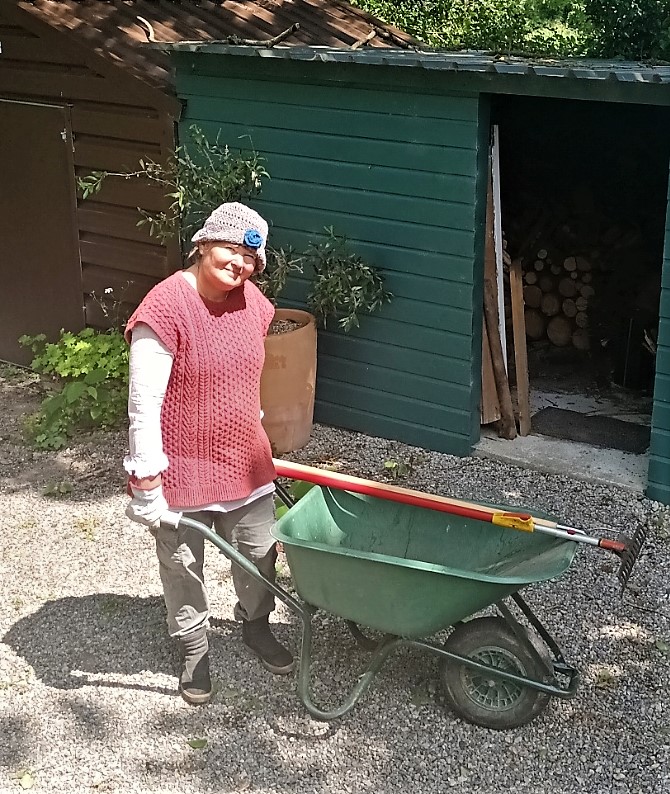
We spent a few weeks in Croatia adjusting again to Mediterranean gardening but learning from past experience to not over water the rosemary and lavender but before we left I tackled what has been a problem now for a few years at the garden at Old Spa Road, a wooden decking patio in the Lower Field which we built out over the stream in 2006 and which was actually the first project in the garden .
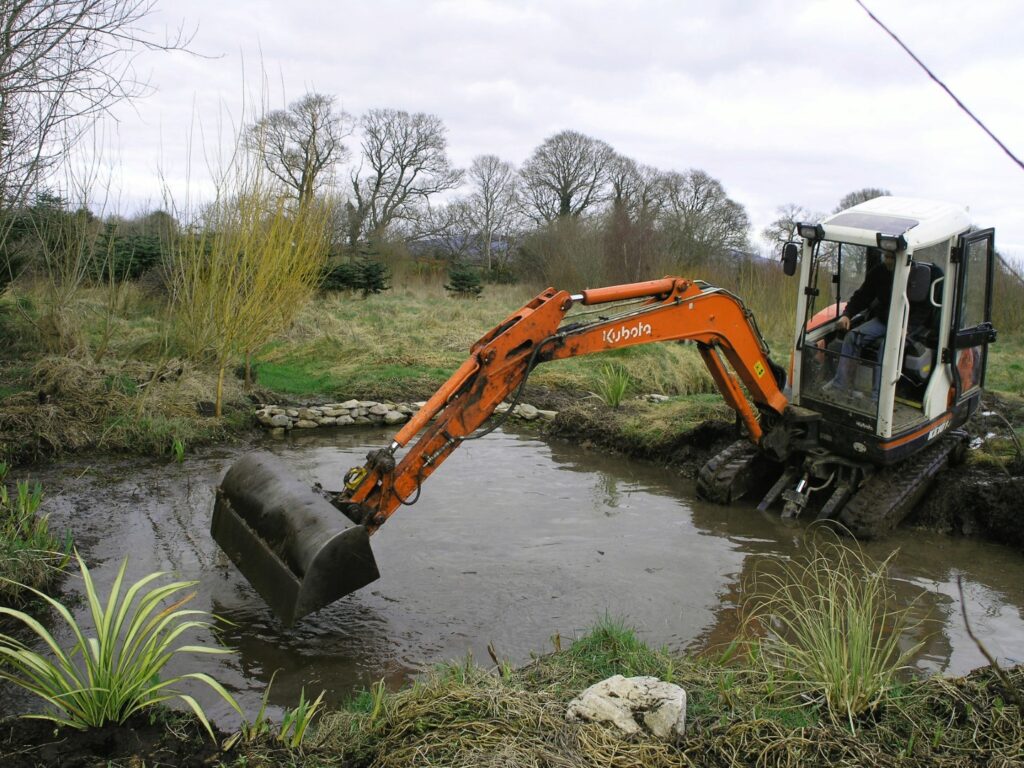
Over the years the decking had rotted away in places and had become quite unsafe as well as unsightly so it had to be replaced but with what … I had originally planned this south facing patio as a place to sit and eat but we never actually used it as such so the plan now was to replace it with a single span walkway across to the little island .
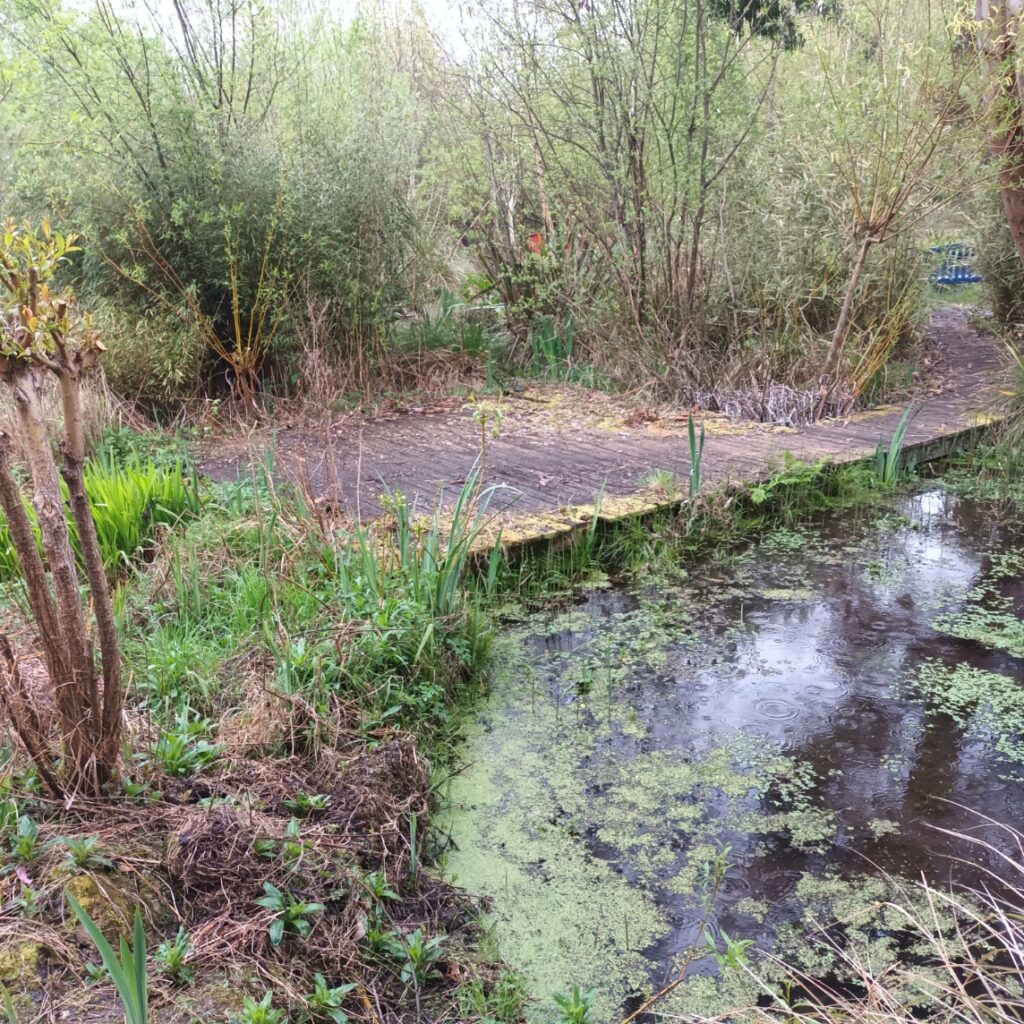
I was sad to see an original structure go and it brought me back to the excitement of the initial planning of the garden and how the overall design of the garden has evolved in the past seventeen years and indeed how our own thoughts about the design of the garden had changed in the same period .
We used a small digger to dig out the ground under the wooden pathway and flooded it from the natural flow of the stream , this enlarged the existing water area and finally bridged the water with a single walkway .

Next step was to do something with the bank where the patio had butted up to and I used concrete slabs to make a small patio with space for a chair or two , added some left over indian sandstone slabs from ten years ago to house three pots sourced from other areas of the garden and this is now a favourite place to end the day in the garden looking out over the water to the sunset and I am delighted with the end result .
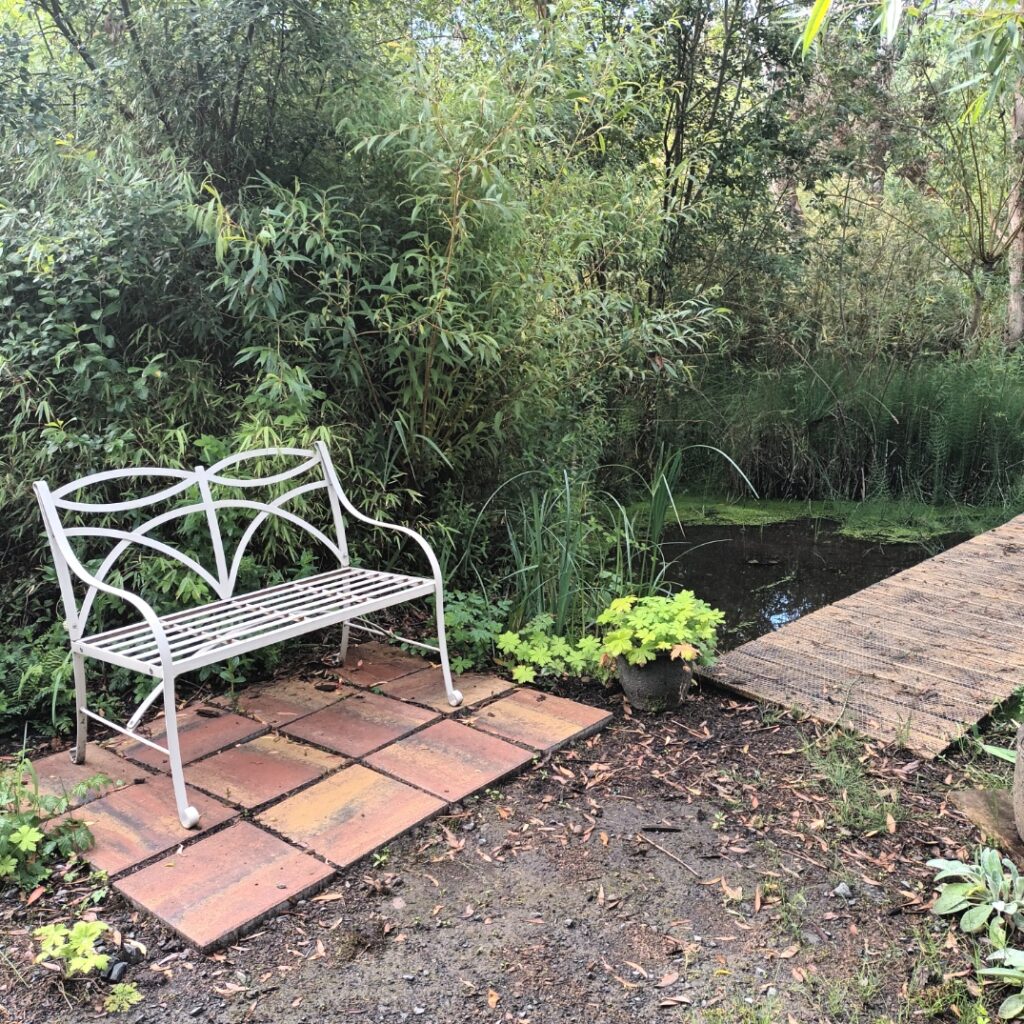
I am always asked what is the perfect tree for a small garden and while my first choice is always a silver birch jacquemontii however if your garden has a little wiggle room then consider the purple willow , salix purpurea pendula , which is a grafted tree and can be ordered at different heights in the garden centres .
I use three of them along the main path to the Lower Garden and love their untidy sprawl as the weeping purple willow is an unruly small tree that throws it’s branches around in all directions as if it can’t make up it’s mind which way to grow so give it plenty of room if planting it along a path … but it has one deadly flaw in that as a grafted rootstock it suckers madly from the original main stem … mostly it will behave itself but if it start’s suckering you will ned to be vigilant and cut back harshly all the emerging suckers and when I say harshly I mean don’t use a secateurs to make nice gardening cuts , just rip off the suckers and this will discourage or at least reduce the vigour of the off shoots .

Mary Reynolds is an Irish gardener and designer I really admire who for many years of her career was a traditional garden designer with a gold medal at Chelsea on her CV but for the past few years Mary has become a gardening activist and eco warrior who is now much in demand on large rewilding projects …her Face Book Page is worth following .
https://www.facebook.com/maryreynoldsnatureactivist
I once spent a day in her company along with Diarmuid Gavin when we were invited on the RTE Marion Finucane radio show where my part was to describe the contrast in gardening in Ireland and the Adriatic Coast of Croatia … Mary was and remains a vivacious personality , irrepressible in her love for all things ecological and while I draw the line at howling naked at midnight at the full moon … OK I made the naked bit up … I follow her writings regularly and particularly like what she wrote last week about cutting the lawn , especially how she manages to link our cutting the lawn to our Irish lack of poshness and history of colonisation !
The Cult of the Lawn by Mary Reynolds .
Lawns became a “thing” in the 16th and 17th centuries, a way for the upper classes to show off…a demonstration of their dominance, that they had the resources to create ornamental gardens around their homes. Resources included bucket loads of servants who used sickles and scissors to maintain the short grass carpets. These short areas of grass were kept for games such as lawn tennis and croquet. And drinking tea.
Then, with the invention of the lawnmower, the middle classes made an effort to emulate the posh people by keeping a lawn. A demonstration that they had more than enough land , that they did not need to grow food on every last inch of it.
They had made it.
My lawn is self willed and it’s community is decided by the land here. I am addicted to lying in it because the honey smell of the clover (native to Ireland) makes everything better in my world. It’s intoxicating and hopping with pollinators.
How anyone would think a toxic bowling green lawn is better than this needs to wake up and smell the honey.
It’s time to let go of all those colonial underpinnings…a new world beckons.
My own little rewilding experiment in the Lower Field has taken off and is now an established part of the garden and after a year or so the various small trees added in January will thicken up and add extra structure . I will also add in some pockets of wet loving perennials such as darmera , camasia and iris bulbs plus a few extra silver birch whips from November onwards and have already planted up some gunnera this Spring that will add some drama … onwards and upwards on the rewilding front !
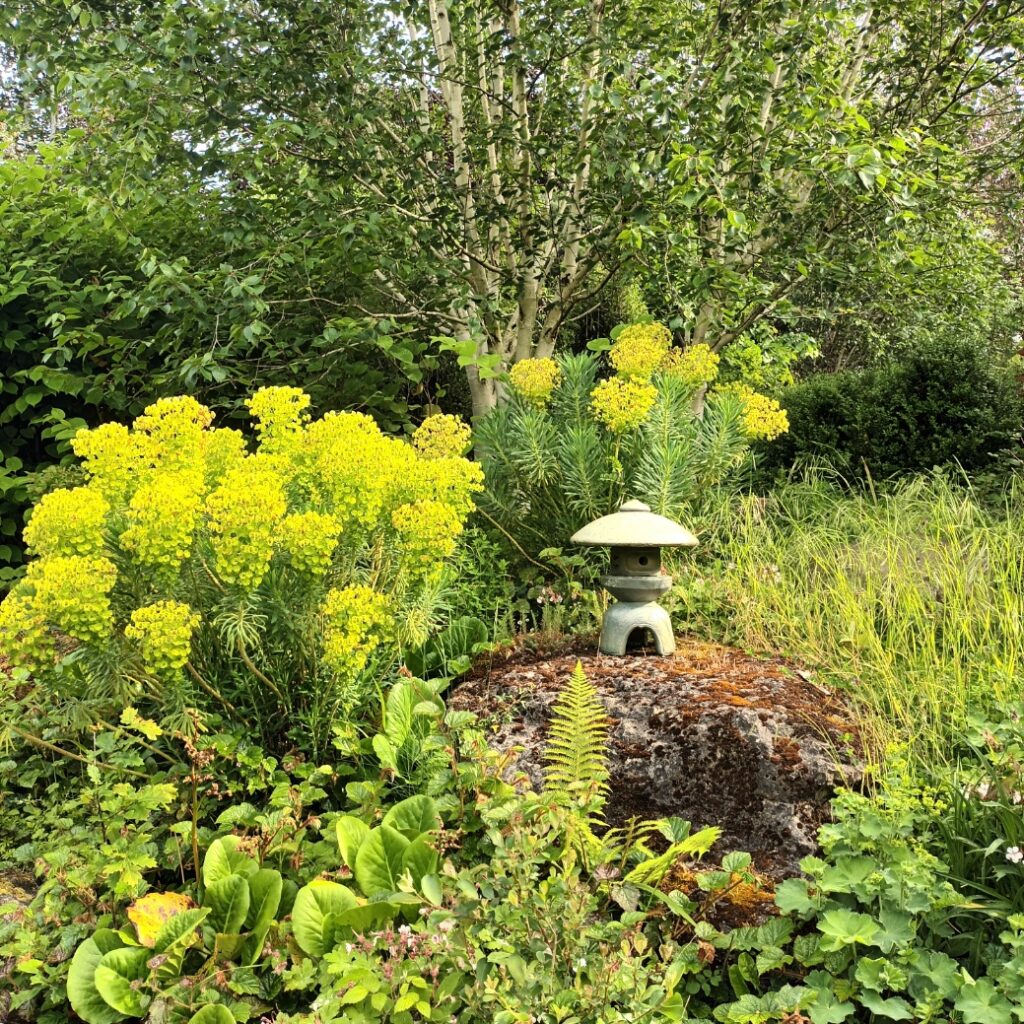
Towards the end of June the euphorbia bracts have just faded after flowering non stop since late March but need to be cut out now to ensure the new shoots come through from the base where they are tucked in beneath the bracts and these will grow twice their size by the end of September and will be ready to flower next March … the cut is necessary and although no one likes to reduce their euphorbia clumps in the middle of summer and it does leave a gap in the borders but by September it will have recovered … not doing it will mean your euphorbia will struggle on to next year with lesser flower bracts and the plant will actually die out in a year or two .
But be ruthless now and your euphorbia will be rejuvenated and come back bigger and stronger than ever and just to define ruthless , I cut out 72 shoots from the one euphorbia in the photos below … SEVENTY TWO … not all of these were shoots that had just flowered but were older woody shoots and this thinned out the clump and will give it a great start for next Spring .
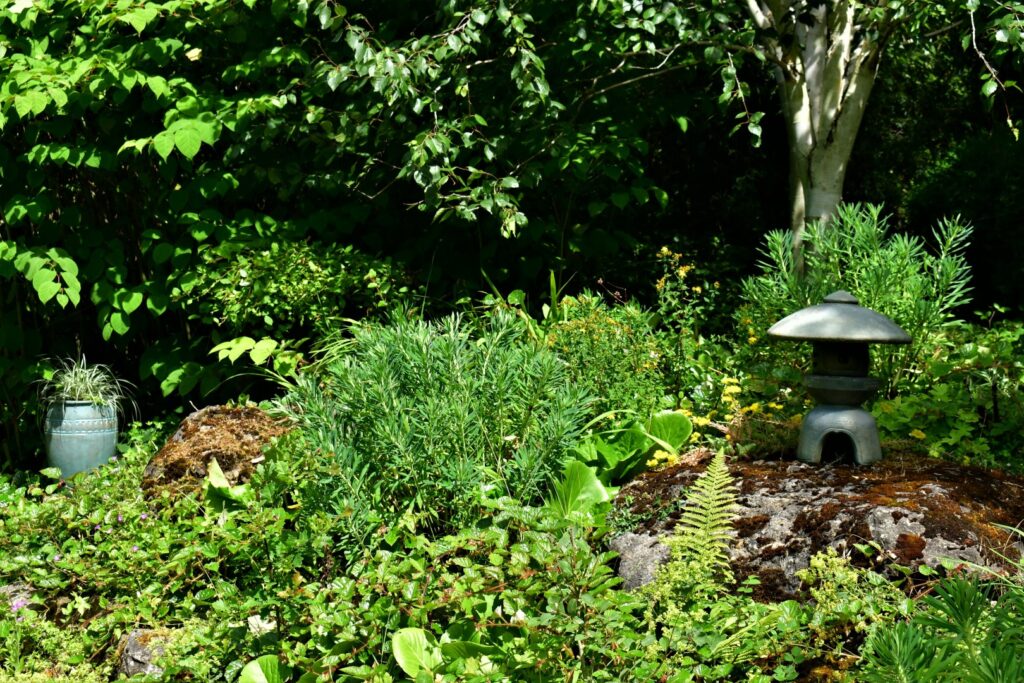
As I mentioned we had spent some time in Croatia in June working on maintaining the Mediterranean garden and while it is really nice to do garden work in the Spring in that climate it is a different experience in the heat of June and you are limited to working very early as from mid morning onwards the heat is killing and the norm for local people is to be in the garden as early as 5 am .
Actually when I got back to Old Spa Road and walked into the garden here I realised that in a Mediterranean garden you are very limited both in what you can plant but also in how you enjoy the garden as a walk around the garden from noon onwards in the searing heat of Summer is all about shade and how to remain in it as otherwise you get burnt to a frazzle … and not many articles praising Mediterranean gardens will tell you this !
A mediterranean garden is defined by a mix of drought tolerant plants , relaxed seating in shade , gravel paths and usually but not always terracotta pots although terracotta being named one of the garden colours of the year for 2023 … and with pots small doesen’t do it so big earthenware pots are the classic look .
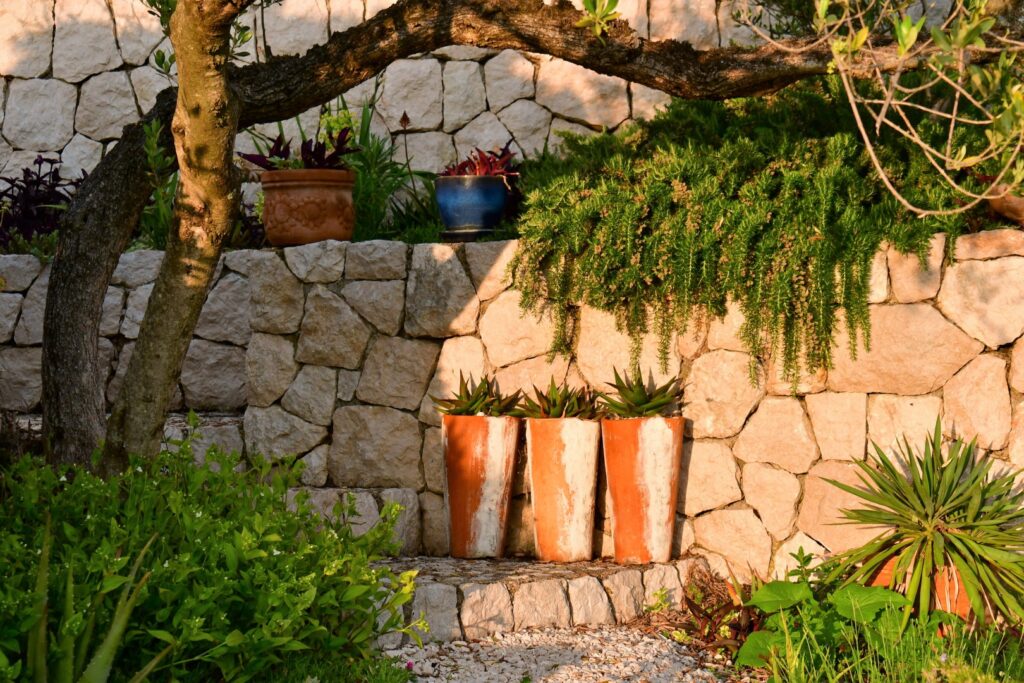
You never hear the word “ rewilding ” when talking about a Mediterranean garden and the laid back low maintenance style centered on alfresco dining is key .
The gorgeous scenes of rocky slopes that you see in magazines with olive trees and punctuating cypresses are the product of a harsh and unforgiving environment as a recent article in Vogue says “What is a joyful holiday destination for us, is a tough environment for plants and it really picks the winners from the losers – severe drought, high summer heats and poor gravelly soil are some of the influences that have made these landscapes such unique, beautiful places.”
The famous Mediterranean and Adriatic gardens are all about views out from within and rely on garden sculpture and huge terracotta pots to provide points of dramatic interest .
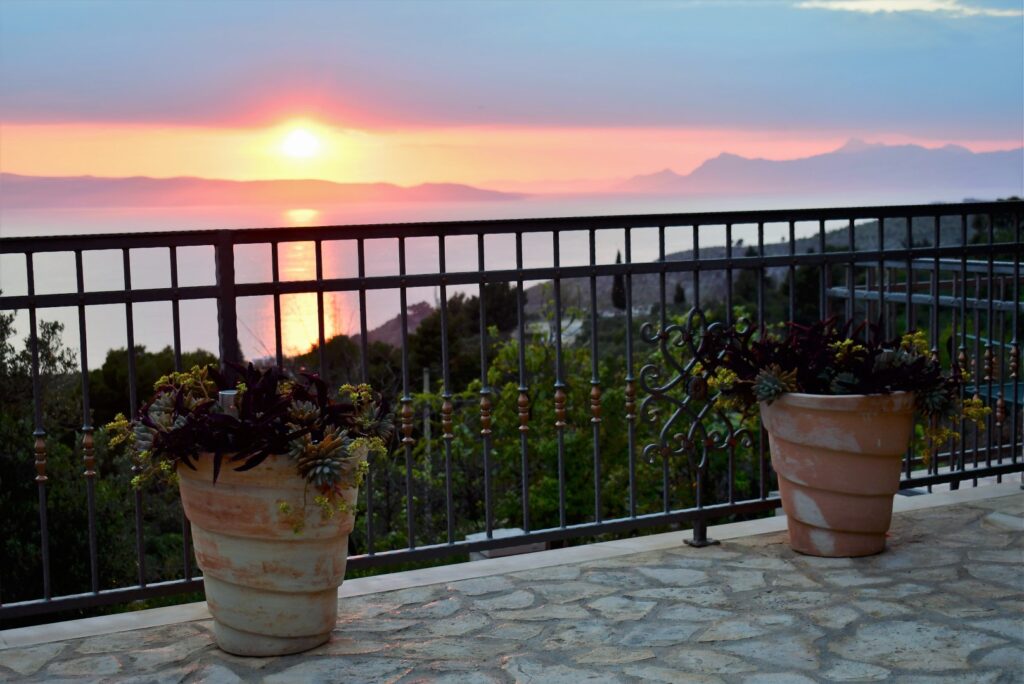
Shirley Lannigan , the Irish garden writer , visited last week as she is writing a new book about Irish Gardens and wanted to see first hand how the garden has changed since her article about Petrovska Garden in the Irish Garden magazine in 2015 and the entry about us in her last book , The Open Gardens of Ireland published in 2017 .
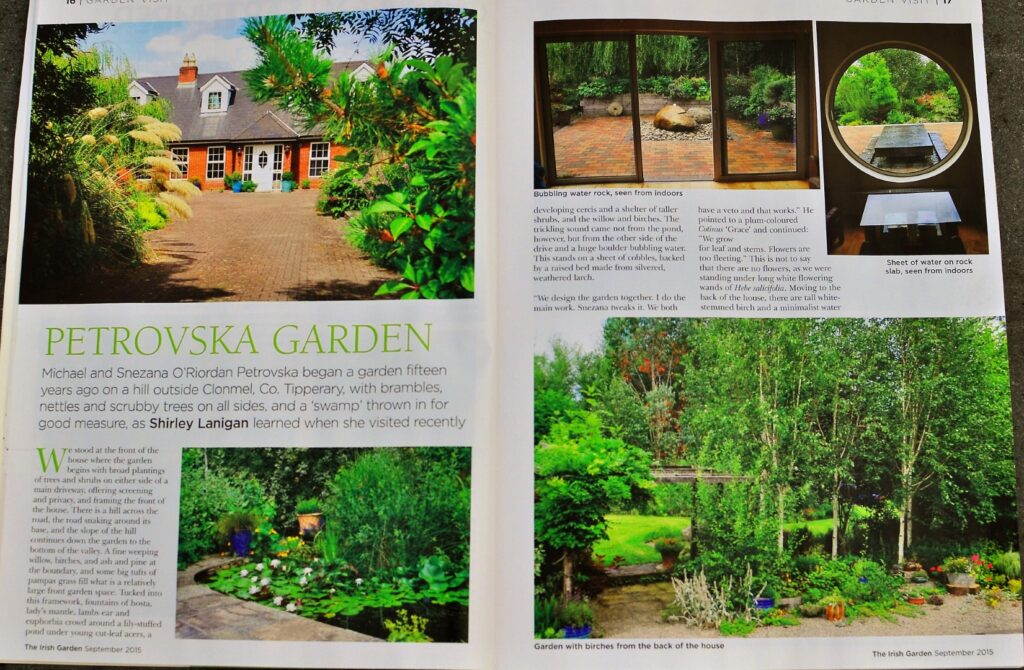
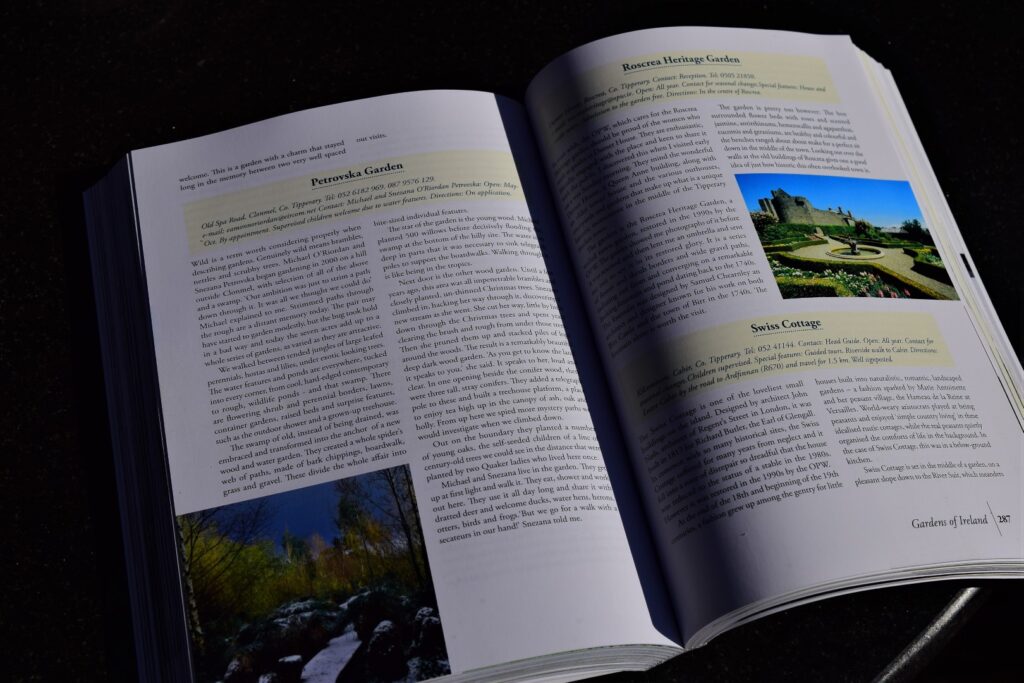
We enjoyed catching up with Shirley and walked with her around the various new projects of the past four years such as the Rock Garden and the Water Garden enlargement in the Lower Field … a highly knowledgeable gardener in her own right and a true believer and advocate of rewilding , Shirley and Snezana are fellow natural world warriors who have always bonded on no spraying , no weed killer , let the slugs eat everything so eventually I just supplied the coffee and let them get on with their eco dreams !
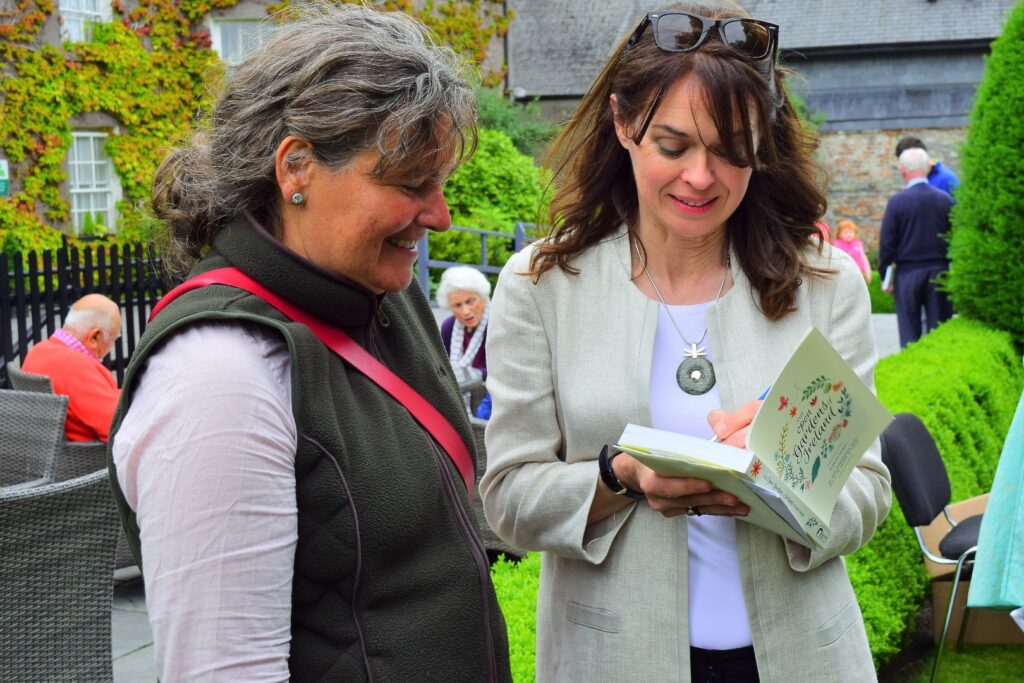
I often say that our garden is not the garden it could be or as I would like it to be and the reason is that invaders such as deer are eating whatever they fancy and for example the edges of our woodland area are perfect for acers and I would pack the area with purple leaf maples or unique trees such as the paper bark maple or parrotia persica , the persian ironwood but they are eaten almost overnight by the huge population of deer that consider our area fair game … I had really wanted a parrotia tree in the Lower Field in a particular area and tried two at separate times and literally overnight each tree was bitten in two by the deer … deer look like bambi but are really destructive animals .
If we can get a new tree past the first few years in the ground then we have a chance as older trees are not attacked by the deer and the few nice specimen trees that have survived were planted over fifteen years ago when the deer population was less numerous but now there is no official culling programme and all over the mountains of Ireland the deer population is out of control … Snezana found a large group of over twenty deer , young and old , snacking on our apple trees a few evenings ago and perhaps it is time to enroll in rifle firing classes !
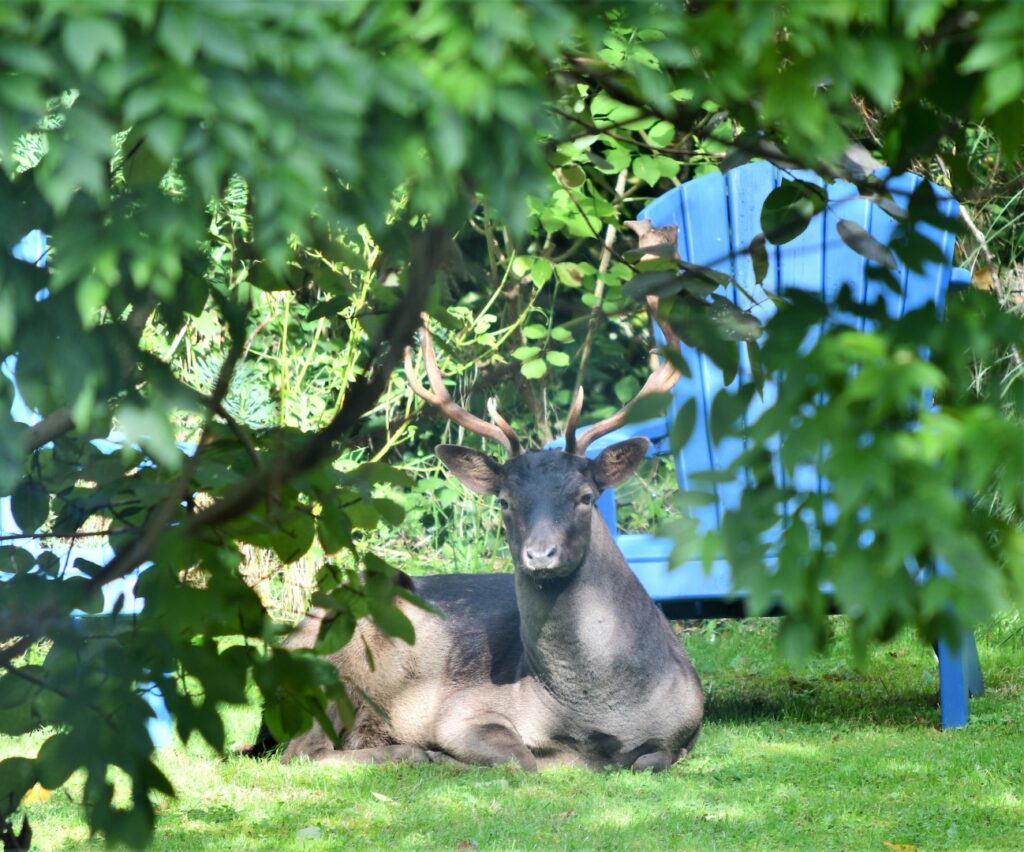
Visit to Blarney Castle and Gardens
In June I took Snezana to visit Blarney Castle for the first time thinking she might like to kiss the famous Blarney Stone or at least see where we Irish who have kissed it get their eloquence or the Gift of the Gab !
Blarney Castle was the stronghold of the MacCarthy Clan one of the most important Gaelic Chieftains and Kings of Munster , built in 1446 by Cormac MacCarthy when the famous stone was built into the wall . Various legends are attached to the Stone , that it was brought back from the Holy Land where Jacob had used it as his pillow when he dreamed of a staircase to heaven and another that it was a gift from Robert the Bruce and was part of the coronation Stone of Scotland and England … the stone itself is 330 million years old and whatever legend you believe they all state that whoever kisses it will have the gift of eloquence !

The castle itself is now just a ruin but you can climb to the top via a nasty little stone staircase , quite tight with no room to pass and the famous Blarney Stone is out on the roof of the tower with a fabulous view out over the countryside . I was blown away by the Blarney gardens as normally these Castle gardens are generally parkland and quite bland but Blarney gardens are spread out for 60 acres over hilly ground built around the River Martin with paths connecting rock , water and perennial gardens and what I really liked is they have achieved the perfect balance between the cultivated and wild areas all the while looking neat and well kept … the whole experience is magical and I really recommend a visit if in the Cork area … not cheap though at 20 Euros per person plus 10 Euros to visit the house .
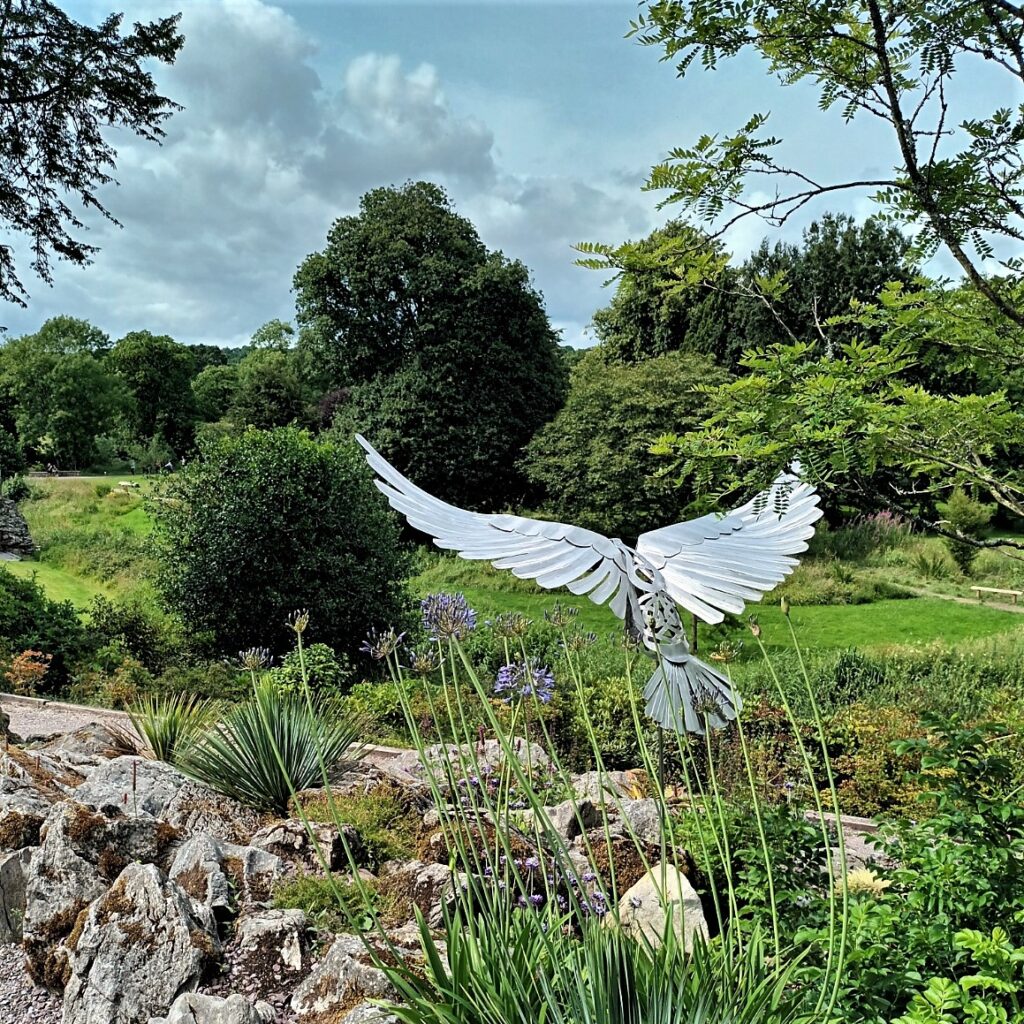
I had kissed the Blarney Stone back in 1974 but of course after almost fifty years the promised eloquence needed renewing and so we found ourselves shuffling along at the top of the parapet in a line of people all waiting for their chance to kiss the stone … not many go back as it is set out over an open chimney 100 feet up I have always remembered how awkward and downright dangerous it is , Google is blunt about it
“ So, if you’re wondering why people kiss the Blarney Stone upside down, the simple answer is that it’s the only way to reach it. Due to its placement in the castle wall below the battlements, visitors have to lie down, lean back while gripping the iron rails, and kiss it. Staff will also be there to hold and assist you.
This is much safer than how people used to kiss the stone. Visitors were formerly taken over to the stone and kissed it with their ankles tied together! Well, as they say, if it were easy, everyone would be doing it !”

I didn’t enlighten Snezana beforehand as to just how awkward it is to kiss the Blarney Stone and she probably thought it was just a matter of planting a kiss on an old stone at waist high level … easy peasy … but the closer she got up on the roof parapets of the caste to the actual thing itself in the queue the more she had made up her mind on it and as her turn came she looked down the 100 feet of the open chimney and the iron bars to hang on to UPSIDE DOWN and made a quick decision “ no f..king vey ” !
This is what happens at Blarney Castle when you don’t kiss the Stone !

I had remembered from my last time in 1974 NOT to look down as I swung out backwards and upsidedown while holding on to the bars my legs being held at the waist by an attendant but my neck muscles aren’t what they were in 1974 so I couldn’t manoeuvre myself to plant a kiss on the stone so ended up blowing a kiss to it … thought I had done my duty but of course Snezana who was watching said “ call that a kiss ?
Nothing for it but to try again and this time I said to the guy holding my legs you have to swing me in close but he whispered you won’t manage it if your neck is too stiff … encouraging guy all right , he must have been having an off day … anyway he and I both swung me in upside down close to the stone again and not only did I kiss the bugger this time I head butted it all the way back up and a week later I still have the scratches on my forehead !
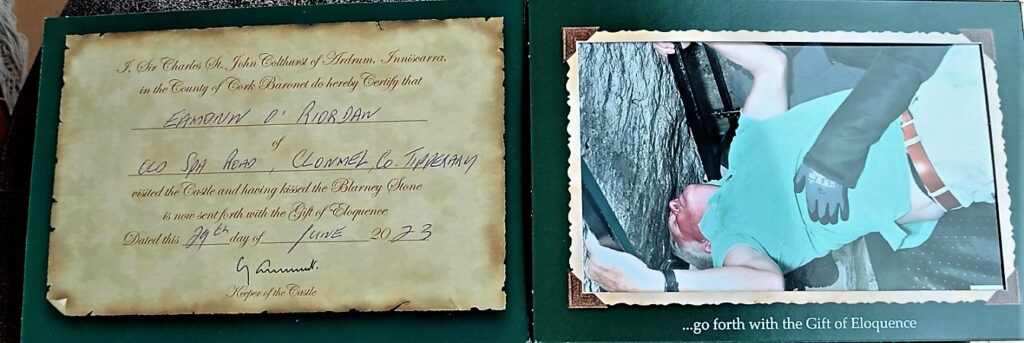
Colour in the Garden in June 2023
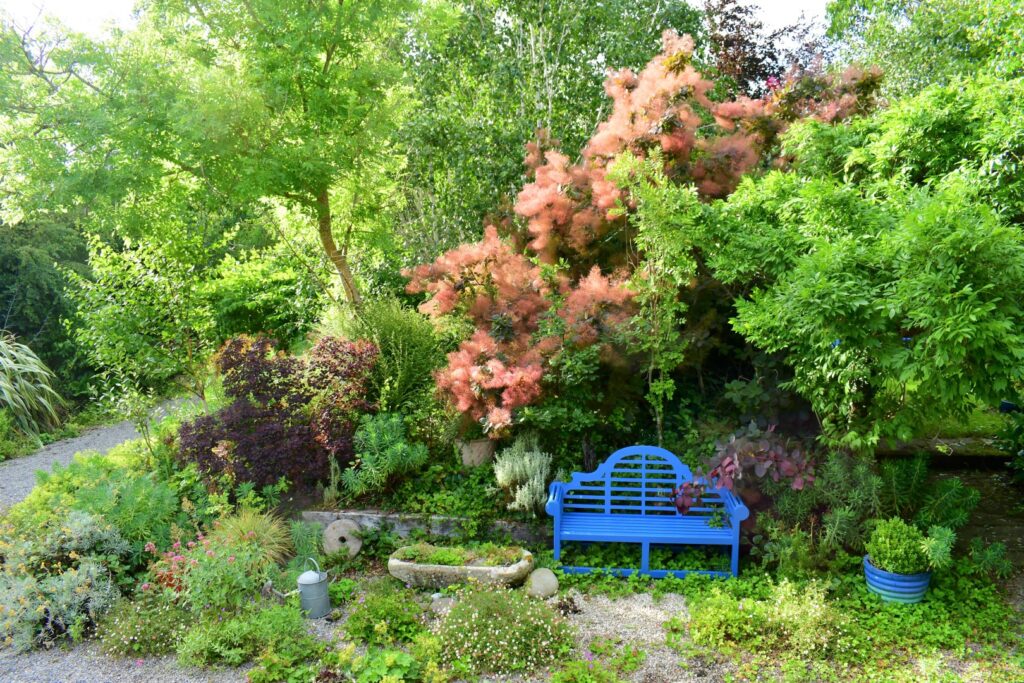
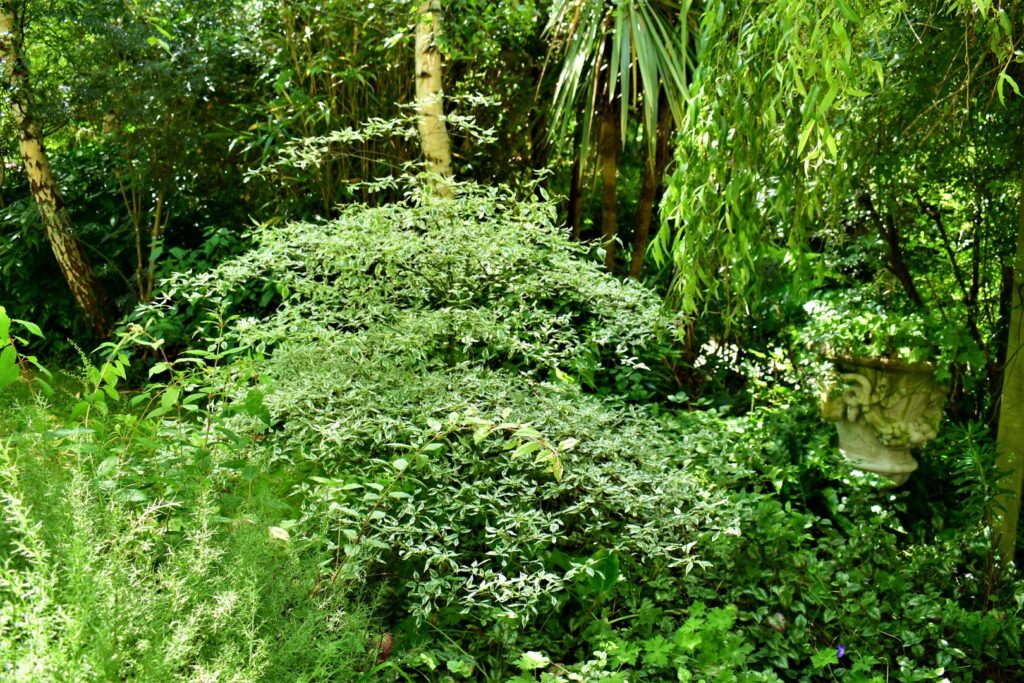
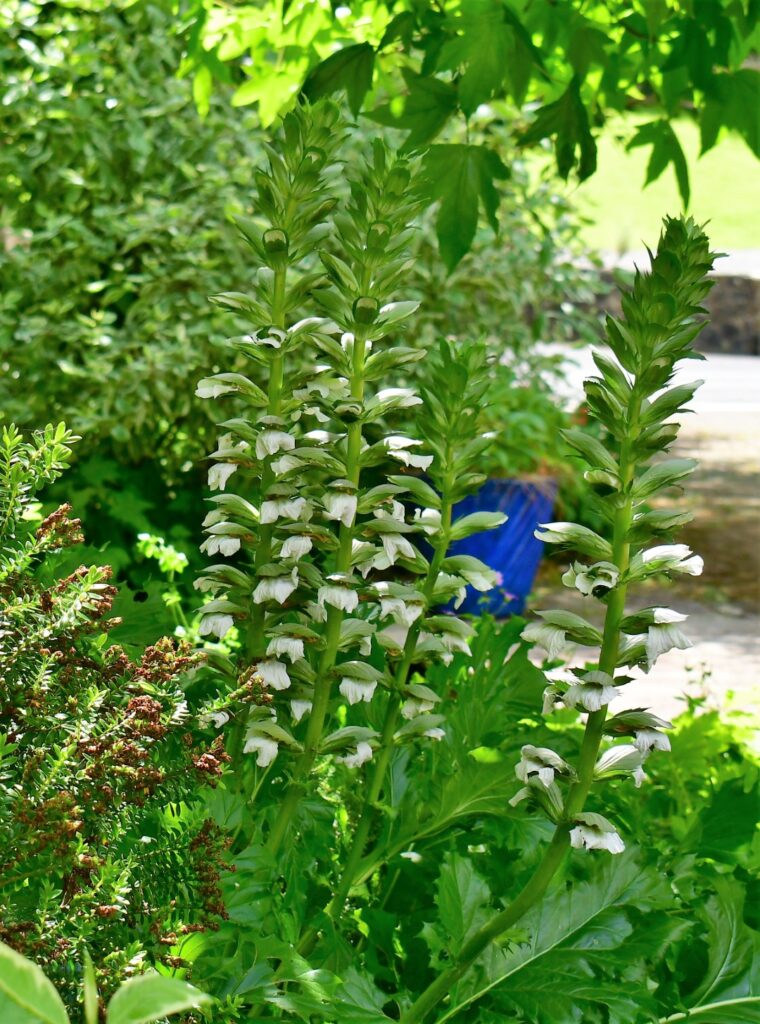
I often write about Rhus Cotinus especially it’s best variety Grace and this year it has been a great performer probably a combination of early summer rain and heat and visitors to the garden always ask about it when confronted with the purple colour .
The common name for rhus cotinus is the smoke bush tree and usually it is difficult see how it got it’s name especially when you explain that this is because after flowering it resembles a smokey mass hovering over the shrub … as generally the phenomenon is so small that it is insignificant … not this year as for some freak of the weather there is no mistaking as to why it is called the Smoke Bush Tree and a shrub that normally is a show stopper is a stand out performer in the garden .

Enjoy the Summer !


Leave a Reply